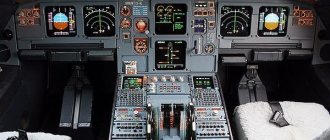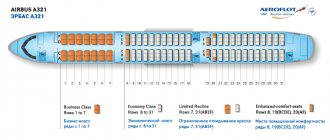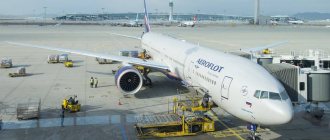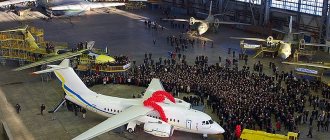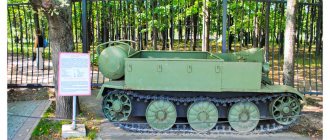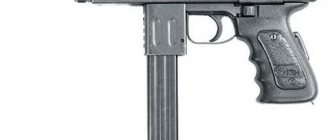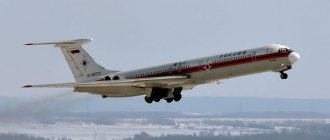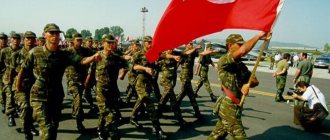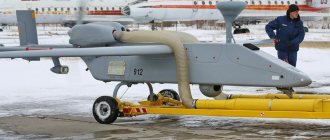| Airbus A350 | |
| Airbus A350 during its first flight. | |
| Type | passenger plane |
| Developer | Airbus |
| Manufacturer | Airbus |
| First flight | June 14, 2013 [1] |
| Start of operation | January 15, 2020 |
| Status | operated, produced |
| Operators | Finnair Qatar Airways Cathay Pacific Singapore Airlines |
| Years of production | 2015 - present |
| Units produced | 203 [2](September 30, 2020) |
| Unit cost | A350-800: US$260.9 million (2014),[3] A350-900: US$295.2 million (2014),[3] A350-1000: US$340.7 million (2014)[3] |
| Images on Wikimedia Commons | |
Airbus A350 XWB
(eng. E
x
tra
W
ide
B
ody - ultra-wide fuselage) is a family of long-range wide-body twin-engine passenger aircraft developed by Airbus as a replacement for the A330 and A340. The A350 is the first Airbus aircraft to feature a fuselage and wing primarily made of carbon fiber.[4] It can carry from 250 to 350 passengers in a typical three-class configuration, with a maximum capacity of 440–550 passengers, depending on the version. The launch customer for the A350 is Qatar Airways, which has ordered 80 aircraft (of all three variants)[5]. The A350 prototype made its first flight on June 14, 2013 in Toulouse-Blagnac, France.[6] The first type certificate was issued on September 30, 2014 by the European Aviation Safety Agency for the A350-900 variant with Rolls-Royce Trent XWB engines[7]. Operation of the airliner by airlines was planned to begin in mid-2014[8].
Development and development costs are projected to be €12 billion ($15 billion)[9]. As of April 2014, Airbus had received orders for 812 aircraft from 39 different customers around the world.[5]
On 15 January 2020, Qatar Airways' A350 XWB took off on its first commercial flight, from Doha to Frankfurt, with passengers on board.
History of creation
Having announced the Boeing 787 Dreamliner project, Boeing Corporation said that the lower cost of operating this aircraft would deal a serious blow to the position of the Airbus A330. Airbus was initially dubious about the announcement, pointing out that the 787 was merely a reaction to the A330, and for its part did not see the need to take any retaliatory steps.
The airlines agreed with Airbus to create a competitor because, according to Boeing, the 787 model should consume 20% less fuel than existing analogues. Airbus initially planned to create a model based on the A330, informally called the "A330-200Lite", which would have improved aerodynamics and engines similar to the Boeing 787.
The initial version was conceived in 2004 with a fuselage based on the A330 and the same layout, but with a significantly updated design. The airlines were not satisfied with this option, and later, at the request of potential customers, they abandoned this idea. Airbus has allocated 4 billion euros to develop a new model called the A350. New wings, engines and tail fins, combined with new composite materials and fuselage manufacturing techniques, made the A350 an almost entirely new aircraft.
In 2006, Airbus redesigned the project and renamed it the A350 XWB. Airbus stated that the aircraft will be more fuel-efficient and its operating costs will be 8% lower than the Boeing 787 Dreamliner[4].
Play media file
Airbus A350 Qatar Airways
A350 XWB
In response to airline requests, Airbus significantly revised the A350 concept in mid-2006. The modified project received the abbreviation XWB - Extra Wide Body (additionally extended fuselage). The new variant will have to compete with the more spacious Boeing 777, as well as some Boeing 787 models. The A350 XWB can accommodate up to 9 passenger seats in one row. The A330 and previous A350 concepts could only have 8 passenger seats in each row. The 787 can seat 8 or 9 passengers per row, while the 777 can accommodate 9 (rarely 10) seats. At seated eye level, the A350 cabin is 33 cm wider than the A330 cabin and 13 cm wider than the 787 cabin; but 27 cm narrower than the Boeing 777 cabin. All passenger modifications of the A350 XWB have a flight range of at least 15,000 km.
On December 4, 2012, the first copy of MSN1 was rolled out of the assembly shop hangars. On June 14, 2013, the aircraft made its first flight, beginning the flight test program. The first aircraft to take off was the A350-900 modification with registration number F-WXWB. Take-off weight was 221 tons. The second aircraft flew on October 14, 2013 under the registration number F-WZGG.[10]
An excerpt characterizing the Airbus A350 XWB
Stopping opposite the Pavlograd regiment, the sovereign said something in French to the Austrian emperor and smiled. Seeing this smile, Rostov himself involuntarily began to smile and felt an even stronger surge of love for his sovereign. He wanted to show his love for the sovereign in some way. He knew it was impossible, and he wanted to cry. The Emperor called the regimental commander and said a few words to him. "My God! what would happen to me if the sovereign addressed me! - Rostov thought: “I would die of happiness.” The Emperor also addressed the officers: “Gentlemen, every word was heard by Rostov like a sound from heaven,” I thank you with all my heart. How happy Rostov would be if he could now die for his Tsar! – You have earned the banners of St. George and you will deserve them. “Just die, die for him!” thought Rostov. The Emperor also said something that Rostov did not hear, and the soldiers, pushing their breasts, shouted: Hurra! Rostov also screamed, bending down to the saddle as much as he could, wanting to hurt himself with this cry, only to fully express his admiration for the sovereign. The Emperor stood for several seconds against the hussars, as if he was undecided. “How could the sovereign be indecisive?” thought Rostov, and then even this indecision seemed to Rostov majestic and charming, like everything that the sovereign did. The sovereign's indecisiveness lasted for an instant. The sovereign's foot, with a narrow, sharp toe of a boot, as was worn at that time, touched the groin of the anglicized bay mare on which he was riding; the sovereign's hand in a white glove picked up the reins, he set off, accompanied by a randomly swaying sea of adjutants. He rode further and further, stopping at other regiments, and, finally, only his white plume was visible to Rostov from behind the retinue surrounding the emperors. Among the gentlemen of the retinue, Rostov noticed Bolkonsky, sitting lazily and dissolutely on a horse. Rostov remembered his yesterday's quarrel with him and the question presented itself whether he should or should not be summoned. “Of course, it shouldn’t,” Rostov now thought... “And is it worth thinking and talking about this at a moment like now? In a moment of such a feeling of love, delight and selflessness, what do all our quarrels and insults mean!? I love everyone, I forgive everyone now,” thought Rostov. When the sovereign had visited almost all the regiments, the troops began to pass by him in a ceremonial march, and Rostov rode in the Bedouin newly purchased from Denisov in the castle of his squadron, that is, alone and completely in sight of the sovereign. Before reaching the sovereign, Rostov, an excellent rider, spurred his Bedouin twice and brought him happily to that frantic trot gait with which the heated Bedouin walked. Bending his foaming muzzle to his chest, separating his tail and as if flying in the air and not touching the ground, gracefully and high throwing up and changing his legs, the Bedouin, who also felt the sovereign’s gaze on him, walked excellently. Rostov himself, with his legs thrown back and his stomach tucked up and feeling like one piece with the horse, with a frowning but blissful face, the devil, as Denisov said, rode past the sovereign. - Well done Pavlograd residents! - said the sovereign. "My God! How happy I would be if he told me to throw myself into the fire now,” thought Rostov. When the review was over, the officers, the newly arrived ones and the Kutuzovskys, began to gather in groups and began talking about awards, about the Austrians and their uniforms, about their front, about Bonaparte and how bad it would be for him now, especially when the Essen corps would approach, and Prussia will take our side. But most of all, in all circles they talked about Emperor Alexander, conveyed his every word, movement and admired him. Everyone wanted only one thing: under the leadership of the sovereign, to quickly march against the enemy. Under the command of the sovereign himself, it was impossible not to defeat anyone, Rostov and most of the officers thought so after the review. After the review, everyone was more confident of victory than they could have been after two won battles. The next day after the review, Boris, dressed in his best uniform and encouraged by wishes of success from his comrade Berg, went to Olmutz to see Bolkonsky, wanting to take advantage of his kindness and arrange for himself the best position, especially the position of adjutant to an important person, which seemed especially tempting to him in the army . “It’s good for Rostov, to whom his father sends 10 thousand, to talk about how he doesn’t want to bow to anyone and won’t become a lackey to anyone; but I, who have nothing but my head, need to make my career and not miss opportunities, but take advantage of them.” He did not find Prince Andrei in Olmutz that day. But the sight of Olmütz, where the main apartment stood, the diplomatic corps and both emperors lived with their retinues - courtiers, entourage, only further strengthened his desire to belong to this supreme world. He knew no one, and, despite his smart guards uniform, all these high-ranking people, scurrying through the streets, in smart carriages, plumes, ribbons and orders, courtiers and military men, seemed to stand so immeasurably above him, a guards officer, that he did not They just didn’t want to, but also couldn’t acknowledge its existence. In the premises of Commander-in-Chief Kutuzov, where he asked Bolkonsky, all these adjutants and even orderlies looked at him as if they wanted to convince him that there were a lot of officers like him hanging around here and that they were all very tired of them. Despite this, or rather as a result of this, the next day, the 15th, after lunch he again went to Olmutz and, entering the house occupied by Kutuzov, asked Bolkonsky. Prince Andrei was at home, and Boris was led into a large hall, in which, probably, they had danced before, but now there were five beds, assorted furniture: a table, chairs and a clavichord. One adjutant, closer to the door, in a Persian robe, sat at the table and wrote. The other, red, fat Nesvitsky, lay on the bed, with his hands under his head, laughing with the officer who sat down next to him. The third played the Viennese waltz on the clavichord, the fourth lay on the clavichord and sang along with him. Bolkonsky was not there. None of these gentlemen, having noticed Boris, changed their position. The one who wrote, and to whom Boris addressed, turned around in annoyance and told him that Bolkonsky was on duty, and that he should go left through the door, into the reception room, if he needed to see him. Boris thanked him and went to the reception area. There were about ten officers and generals in the reception room. While Boris came up, Prince Andrei, narrowing his eyes contemptuously (with that special look of polite weariness that clearly says that if it were not for my duty, I would not talk to you for a minute), listened to the old Russian general in orders, who, almost on tiptoe, at attention, with a soldier's obsequious expression on his purple face, reported something to Prince Andrei. “Very good, if you please wait,” he said to the general in that French accent in Russian, which he used when he wanted to speak contemptuously, and, noticing Boris, no longer addressing the general (who ran after him pleadingly, asking him to listen to something else) , Prince Andrey with a cheerful smile, nodding to him, turned to Boris. Boris at that moment already clearly understood what he had foreseen before, namely, that in the army, in addition to the subordination and discipline that was written in the regulations, and which was known in the regiment, and he knew, there was another, more significant subordination, the one that forced this drawn-out, purple-faced general to wait respectfully, while the captain, Prince Andrei, for his own pleasure, found it more convenient to talk with ensign Drubetsky. More than ever, Boris decided to serve henceforth not according to what is written in the charter, but according to this unwritten subordination. He now felt that only due to the fact that he had been recommended to Prince Andrei, he had already become immediately superior to the general, who in other cases, at the front, could destroy him, the guards ensign. Prince Andrei came up to him and took his hand. “It’s a pity that you didn’t find me yesterday.” I spent the whole day messing around with the Germans. We went with Weyrother to check the disposition. There is no end to how the Germans will take care of accuracy! Boris smiled, as if he understood what Prince Andrei was hinting at as well known. But for the first time he heard the name Weyrother and even the word disposition. - Well, my dear, do you still want to become an adjutant? I thought about you during this time. “Yes, I thought,” Boris said, involuntarily blushing for some reason, “to ask the commander-in-chief; there was a letter to him about me from Prince Kuragin; “I wanted to ask only because,” he added, as if apologizing, “that I’m afraid the guards won’t be in action.” - Fine! Fine! “We’ll talk about everything,” said Prince Andrei, “just let me report about this gentleman, and I belong to you.” While Prince Andrei went to report on the crimson general, this general, apparently not sharing Boris’s concepts of the benefits of unwritten subordination, fixed his eyes so much on the impudent ensign who prevented him from talking with the adjutant that Boris felt embarrassed. He turned away and waited impatiently for Prince Andrei to return from the commander-in-chief's office. “That’s what, my dear, I was thinking about you,” said Prince Andrey as they walked into the large hall with the clavichord. “There’s no need for you to go to the commander-in-chief,” said Prince Andrei, “he will say a lot of pleasantries to you, tell you to come to him for dinner (“that wouldn’t be so bad for the service in that chain of command,” thought Boris), but from that further nothing will come of it; us, adjutants and orderlies, will soon be a battalion. But here’s what we’ll do: I have a good friend, adjutant general and a wonderful person, Prince Dolgorukov; and although you may not know this, the fact is that now Kutuzov with his headquarters and all of us mean absolutely nothing: everything is now concentrated with the sovereign; so let’s go to Dolgorukov, I need to go to him, I already told him about you; so we'll see; Will he find it possible to place you with him, or somewhere else, closer to the sun. Prince Andrei always became especially animated when he had to guide a young man and help him in secular success. Under the pretext of this help to another, which he would never accept for himself out of pride, he was close to the environment that gave success and which attracted him to itself. He very willingly took on Boris and went with him to Prince Dolgorukov. It was already late in the evening when they entered the Olmut Palace, occupied by the emperors and their entourage. On this very day there was a military council, which was attended by all members of the Gofkriegsrat and both emperors. At the council, contrary to the opinions of the old men - Kutuzov and Prince Schwarzernberg, it was decided to immediately attack and give a general battle to Bonaparte. The military council had just ended when Prince Andrei, accompanied by Boris, came to the palace to look for Prince Dolgorukov. All the people in the main apartment were still under the spell of today’s military council, victorious for the young party. The voices of the procrastinators, who advised to wait for something without advancing, were so unanimously drowned out and their arguments were refuted by undoubted evidence of the benefits of the offensive, that what was discussed in the council, the future battle and, without a doubt, victory, seemed no longer the future, but the past. All the benefits were on our side. Enormous forces, undoubtedly superior to those of Napoleon, were concentrated in one place; the troops were inspired by the presence of the emperors and were eager to get into action; the strategic point at which it was necessary to operate was known to the smallest detail to the Austrian General Weyrother, who led the troops (it was as if it were a happy accident that the Austrian troops last year were on maneuvers precisely on those fields on which they now had to fight the French); the surrounding area was known to the smallest detail and depicted on maps, and Bonaparte, apparently weakened, did nothing. Dolgorukov, one of the most ardent supporters of the offensive, had just returned from the council, tired, exhausted, but animated and proud of the victory. Prince Andrei introduced the officer he protected, but Prince Dolgorukov, politely and firmly shaking his hand, said nothing to Boris and, obviously unable to restrain himself from expressing those thoughts that most occupied him at that moment, addressed Prince Andrei in French. - Well, my dear, what a battle we fought! God only grant that what will be its consequence be equally victorious. However, my dear,” he said fragmentarily and animatedly, “I must admit my guilt before the Austrians and especially before Weyrother. What precision, what detail, what knowledge of the area, what foresight of all possibilities, all conditions, all the smallest details! No, my dear, it is impossible to deliberately invent anything more advantageous than the conditions in which we find ourselves. The combination of Austrian distinctness with Russian courage - what more do you want?
Design
The A350's design makes extensive use of the latest materials. 52% of the aircraft’s weight is made up of composite materials, 20% is aluminum, 14% is titanium, 7% is steel, 7% is the rest.[11] By comparison, its rival Boeing 787 is made of 50% composites, 20% aluminum, 15% titanium, 10% steel and 5% other materials. Airbus expects the aircraft to have 10% lower operating costs and 14% lower weight per passenger than its competitor.
Wing
The A350 XWB has a composite wing, the same for all three modifications. The wing area will be 443 m² - this is the largest wing ever created for a single-deck aircraft. The wingspan will be 64.8 meters, which is 4.5 meters more than the A330 and the initial version of the A350. This is equivalent to the span of a Boeing 777-200LR/777-300ER, which has a slightly smaller footprint. The wingtips are not traditional for Airbus: they bend upward in the last 4.4 meters in a saber shape. The wing sweep is 31.9°, which will help increase the cruising speed to 0.85 and the maximum speed to 0.89 M.
The new hinged flap mechanization (similar to the A380) allows the spoiler to close the gap between the trailing edge and the flap to be closed with the spoiler. The manufacturer extensively applied computational fluid dynamics and conducted more than 4,000 hours of testing in low- and high-speed wind tunnels, improving the aerodynamic configuration of both the wings themselves and their tips.
The wings are manufactured in a new 46,000 m² site at Airbus Broughton, employing 650 workers, and the facility was built with support from the Welsh Government.
In December 2011, comprehensive testing of the A350 XWB began under the Air System Integration Bench program at the Honeywell Aerospace facility in Mexico City, Mexico.
Power point
The Trent XWB family includes two base engines for three A350 variants. The basic version with a thrust of 370 kN for the A350-900 will be derated for the −800 modification to 330 kN and 350 kN. The A350-1000 modification will be equipped with an uprated version with a thrust of 432 kN. The forced version will have a higher fan speed. In addition, the most powerful version of the fan will have a different blade shape and operate at a higher temperature thanks to the use of new materials.[12] The basic modification of the A350-800 with a take-off weight of 248 tons has a thrust of 330 kN, the version with a 279 t MVM has a thrust of 350 kN. For customers in the Middle East - Qatar Airways and Etihad - Airbus also plans to offer a modification for high-altitude airfields in hot countries (the so-called “hot and high”). This modification provides increased thrust of 350 kN in hot climates and lack of oxygen.
A350 XWB engines are equipped with a fan with a diameter of 3000 mm. The engine is an upgraded version of the Trent 900 (Airbus A380) and Trent 1000 (Boeing 787) engines.
The A350 XWB is equipped with a 1,750 horsepower Honeywell HGT1700 auxiliary power unit (APU), which has a 10% higher power density than the previous generation Honeywell 331 family APU.
The Hamilton Sundstrand emergency aircraft turbine will be able to provide 100 kVA of power in an emergency (comparable to the A380's 150 kVA).[13]
Modifications
Comparative sizes of the three A350 variants
The A350 will be available in three variants: the A350-900 is scheduled to enter service in 2014, the A350-800 in 2014, and the last to enter service is the A350-1000 in 2020.
A350-800
The A350-800, with three comfort classes, will be capable of carrying 270 passengers over a distance of up to 15,700 km. In September 2014, it was announced that the project would be closed in favor of the A330neo.
A350-900
The A350-900 entered service in 2014 and can carry up to 314 passengers in three comfort classes. The maximum flight range is 15,000 km. Airbus claims that the A350-900 is 30% more fuel efficient per seat and has a 25% lower operating cost than the Boeing 777-200ER[14]. The hourly fuel consumption of the A350-900 is 5800 kg/hour compared to 6700 kg/hour for the Boeing 777-200ER[15]. In the future, it is planned to create a cargo modification of the A350-900F (Freighter), as well as a long-haul version of the A350-900R.
A350-1000
The first A350-1000 was presented to the public in July 2020 at the Airbus plant in Blagnac. This largest model of the A350 family will be able to carry 350 passengers in three comfort classes. The maximum flight range is 14,800 km. The wing area of the A350-1000 is increased by approximately 4% compared to the A350-800/900 versions. The A350-1000 has three-axle main landing gear, like the Boeing 777. The aircraft first took off from the Airbus airfield in Toulouse on November 24, 2020 [16]. The first operator was Qatar Airways.
A350 Ultra Long Range
On February 28, 2020, the first A350 XWB with an extended flight range (A350 Ultra Long Range) was assembled at the Airbus plant in Toulouse. This is the newest modification of the A350 XWB family, the launch operator of which will be Singapore Airlines.
Singapore Airlines has ordered a total of seven A350-900 Ultra Long Range aircraft, which it will begin operating on flights from Singapore to the United States later this year, including the world's longest commercial flight, Singapore-New York.
The next stage of the production process will be extensive static testing of the assembled aircraft, after which the engines will be installed. Next, a flight test program will begin, within which it is planned to certify modifications to this model: a modified fuel system, which allows increasing the fuel capacity of the tanks by 24,000 liters, as well as modified wingtips, which will further improve aerodynamics.
With a maximum take-off weight of 280 tonnes, the A350 XWB Ultra Long Range will be able to operate flights up to 15,600 km or approximately 20 hours, offering operators the best balance between fuel efficiency and passenger comfort.
Airbus A320 seat map
The passenger cabin of the Airbus A320 can accommodate up to 180 passengers. There are 3 toilets on board: 1 in the bow on the left side, 2 in the tail, behind the last passenger row.
The layout of the cabin is determined by the airline: not all flights have business class, and this sector can be equipped differently - with comfortable seats or transformable seats that convert into a bed.
Below are diagrams of the Airbus A320 cabins of popular airlines among travelers from Russia, as well as an overview of the best and worst seats.
Please note: information about the A320 (Red Wings) is also often sought, but currently only the improved Airbus model, the A321, is already used in the carrier’s fleet.
Aeroflot
operates more than 70 Airbus A320 aircraft on regular flights. There are two types of cabin layouts, the main difference being the number of seats in business class.
First option:
- Business class for 20 seats (located in groups of 2), rows - from 1 to 5;
- Economy class - 120 seats (grouped by 3), rows - from 6 to 25;
- The best seats on the Airbus A320 in economy class are Space+ with increased legroom, they are located on row 10 (B, C, D, E).
© aeroflot.ru
Second option:
- Business class for 8 seats (placed in groups of 2), rows 1 and 2;
- Economy class - 150 seats (3 each), rows - from 6 to 30;
- The best Space+ economy class seats are located on row 14, B, C, D, E.
© aeroflot.ru
Bad seats in economy class are considered to be the seats at the end of the cabin near the toilet (in addition, there may not be enough space on the shelf for hand luggage) and the middle ones in each row (there is no personal armrest). This rule works for most aircraft, not just the A320.
Ural Airlines
On the Airbus A320 airliner of Ural Airlines, a layout scheme for 156 seats is being implemented:
- Business class - rows 1–3, 12 seats;
- Economy class - 144 seats, the best (with extra legroom) - on rows 4, 10 and 11.
© uralairlines.ru
S7 Airlines
In the S7 Airlines fleet, European Airbuses are in great demand. In addition to the Airbus A320, the improved Airbus A320neo, as well as the A319 and A321 models, are operated.
Airbus A320 seat map at S7
- Total seats - 158: business class - 8 (arranged in pairs), economy class - 150 (standard - 3);
- Emergency exits are located opposite the seats in rows 10 and 11, and these seats are considered the most successful in economy class - wider legroom;
- The standard bad seats are in the middle (especially for those flying alone) and at the end of the cabin (inconvenient for everyone - there are toilets nearby, there is not enough space on the shelf for hand luggage).
© s7.ru
Seat diagram on Airbus A320neo near S7
- Total seats - 164: business class - 8 (in pairs), economy class - 156 (3 each);
- The best and worst places are the same as in the A320 diagram from S7.
© s7.ru
Russia
The aircraft is in operation - 4 aircraft of the Airbus A321 model. Each aircraft has business class and Space+ seats in economy class.
- Business class - 12 seats, located in rows 1–3;
- Economy class - 156 seats, row numbering - 4–29;
- The best seats in economy (Space+) are row 12, B, C, D, E.
© rossiya-airlines.com
Yamal
The airline's fleet includes 8 Airbus A320-200 aircraft. Depending on the layout, on liners of this type, from 150 to 180 passenger seats can be available. The seats in the cabin are arranged according to the standard 3-3 layout (in economy class), and a comfortable business class is allocated in the bow.
Unfortunately, the official website of the airline does not provide a diagram of the layout of the cabins of its aircraft. Seat selection is also not available when purchasing a ticket on the official website (regardless of the ticket class).
One of the main flights on which the A320 flies: Moscow - Simferopol.
© yamal.aero
Qatar Airways (Qatar Airways)
Qatar Airlines A320 aircraft are equipped with maximum comfort for passengers.
Each aircraft has 12 business class seats, the seats of which can be folded out into a full-fledged horizontal bed 200 cm long.
Personal monitors with an entertainment system, sockets, and USB connectors are available not only in business class, but also in economy class. All these advantages undoubtedly improve the level of even the “unsuccessful” middle seats and the last row.
© qatarairways.com
All features of the A320 from Qatar on the official website
Air Arabia
All airline flights are operated exclusively by A320 aircraft; this carrier has 31 aircraft in its fleet, with plans to expand the fleet to 44.
The advantage of Air Arabia's economy class is the maximum distance between seats - 81 cm (between the same points of two consecutive seats).
Single class, 29 rows. Number of seats - 174.
The best seats on the Airbus A320 layout are rows 1, 2–4 (comfortably located), rows 11 and 12 (more legroom).
© Air Arabia Official Website
Turkish Airlines (Turkish Airlines)
Turkish Airlines has 24 Airbus A320 aircraft. Capacity: 150–159 passengers.
On most flights:
- Business class - 12 seats in rows 1–3;
- Economy class - rows 4–27;
- Emergency exits are at rows 11 and 12.
© turkishairlines.com
Characteristics and seating plan on the official website
Orders and deliveries
As of June 2020, Airbus has received orders for 826 A350 XWB aircraft from 39 of its customers.[5]
Orders by modifications
| A350-800 | A350-900 | A350-1000 | Total |
| 16 | 599 | 211 | 826 |
Etihad Airways
Orders and deliveries by year
| 2006 | 2007 | 2008 | 2009 | 2010 | 2011 | 2012 | 2013 | 2014 | 2015 | 2016 | 2017 | 2018 | Total |
| Orders | 20 | 292 | 163 | 51 | 78 | 31 | 27 | 230 | 32 | 3 | 33 | 810 | |
| Supplies | 1 | 15 | 48 | 82 | 18 | 164 |
[17]Specifications
| Characteristics | A350-800 | A350-900 | A350-1000 |
| Crew | 2 pilots | ||
| Capacity | 280(standard) 440(maximum) | 315(48B+267Y) 325(standard) 440(maximum | 366(standard) 369(54B+315Y) 387(2 class) 440(maximum) |
| Length | 60.54 m | 66.89 m | 73.88 m |
| Wingspan | 64.75 m | ||
| Wing area | 568 m | ||
| Wing sweep | 31,9° | ||
| Height | 17.1 m | ||
| Fuselage width | 5.96 m[18] | ||
| Cabin width | 5.61 m[18] | ||
| Maximum take-off weight | 248,000 kg | 268,000 kg | 298,000 kg |
| Cruising speed | Mach 0.85 (903 km/h, at an altitude of 12,190 m) | ||
| Maximum speed | Mach 0.89 (945 km/h, at an altitude of 12,190 m) | ||
| Range of flight | 15,200 km | 15,000 km | 14,800 km |
| Maximum fuel quantity | 138,000 l | 138,000 l | 156,000 l |
| Service ceiling | 13 100 m | ||
| Engines (2×) | Rolls-Royce Trent XWB | ||
| Engine thrust | 337 kN | 374 kN | 414 kN |
| Run length, m | 2600 | ||
| Run length, m | 2000 | ||
Notes
- Airbus confirms timing for A350 XWB First Flight (inaccessible link - history
). Retrieved June 11, 2013. Archived February 6, 2020. - orders & deliveries
- ↑ 123
Airbus 2014 average price list. Airbus.com (13 January 2014). Retrieved June 1, 2014. Archived February 3, 2014. - ↑ 12
Taking the lead: A350XWB presentation. EADS (December 2006). Archived March 27, 2009. - ↑ 123
Summary, [1]. Airbus, October 2013. Retrieved 31 October 2013. - A350 XWB First Flight
- Airbus A350-900 receives EASA Type Certification | Airbus News & Events (unavailable link - history
). Retrieved September 30, 2014. Archived October 3, 2014. - Airbus advances towards first flight of A350 twinjet. Flight International
(23 Oct 2012). - 15 bln US dollars for Airbus A350. Retrieved July 1, 2011.
- Aviation EXplorer News: Airbus A350 successfully makes its maiden flight
- Airbus's A350 vision takes shape
- Kingsley-Jones, Max
.
RR prepares to ground-test Trent XWB ahead of A380 trials next year, Flight International
(29 April 2010). - "Hamilton Sundstrand to supply Ram Air Turbine for A350 XWB" Archived September 19, 2010.
- John Leahy presentation at Paris Le Bourget 2007 Air Show Archived May 28, 2008. Airbus
- Bjorn's Corner: Increasing an aircraft's range (English)
- Airbus A350-1000 takes off for the first time
- Airbus A350 XWB Production List (English). www.planespotters.net. Retrieved June 30, 2020.
- ↑ 12
A350 Specifications
Links
Military - A310MRTT
- CC-150 Polaris
- A330MRTT
- A400M
- C-212 Aviocar
- CN-235
- C-295
In developing - A320neo
- A330neo
Closed projects - NSR
- KC-45
Other types - Sud Aviation Caravelle
- Aerospatiale-BAC Concorde
- BAC 1-11
